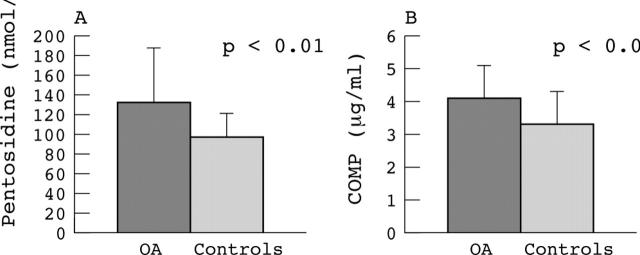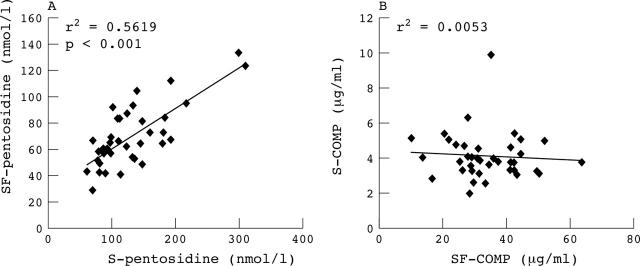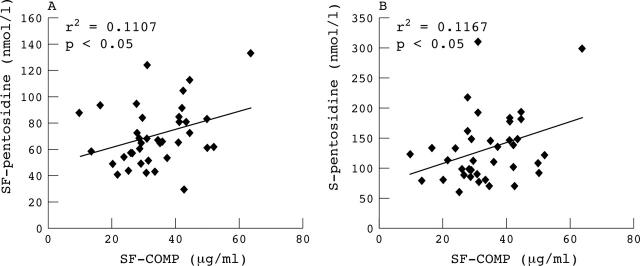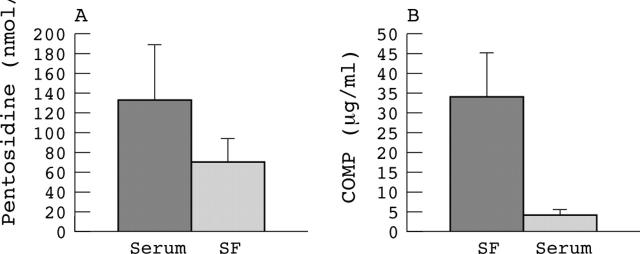Abstract
Background: Pentosidine, an advanced glycation end product, increasingly accumulates in articular cartilage with age, and contributes to the pathogenesis of osteoarthritis (OA). Increased pentosidine concentrations are associated with inflammatory disorders—for example, rheumatoid arthritis.
Objective: To compare pentosidine serum concentrations in patients with knee OA and in healthy volunteers and to determine a relationship between pentosidine and cartilage oligomeric matrix protein (COMP)—a marker of articular cartilage destruction.
Methods: Paired serum and synovial fluid samples were obtained by arthrocentesis from 38 patients with knee OA and from 38 healthy volunteers. Pentosidine concentration was measured by reverse phase high performance liquid chromatography with fluorescent detection and COMP was determined by sandwich ELISA.
Results: Significantly increased serum pentosidine (p<0.01) and COMP (p<0.05) levels were detected in the patients with OA compared with the control group. Serum pentosidine correlated significantly with synovial fluid pentosidine (p<0.001). Pentosidine in synovial fluid (p<0.05) and in serum (p<0.05) correlated significantly with synovial fluid COMP. Pentosidine and COMP concentrations did not correlate significantly with the radiological stage of the disease.
Conclusion: Increased pentosidine serum concentration in patients with OA and its correlation with the cartilage destruction marker COMP in synovial fluid suggests that pentosidine may be important in OA pathology and is a new potential OA marker.
Full Text
The Full Text of this article is available as a PDF (79.0 KB).
Figure 1.
Comparison of the serum levels of (A) pentosidine and (B) COMP in patients with OA and in controls.
Figure 2.
Correlation between serum (S) and synovial fluid (SF) levels of (A) pentosidine and (B) COMP in patients with OA.
Figure 3.
Correlation between (A) pentosidine and COMP in synovial fluid (SF) and (B) pentosidine in serum (S) and COMP in SF in patients with OA.
Figure 4.
(A) Serum levels of pentosidine are significantly increased compared with levels in synovial fluid (SF) in patients with OA (p<0.001). (B) In contrast, serum levels of COMP are significantly decreased compared with levels in SF in patients with OA (p<0.001).
Selected References
These references are in PubMed. This may not be the complete list of references from this article.
- Aigner T., McKenna L. Molecular pathology and pathobiology of osteoarthritic cartilage. Cell Mol Life Sci. 2002 Jan;59(1):5–18. doi: 10.1007/s00018-002-8400-3. [DOI] [PMC free article] [PubMed] [Google Scholar]
- Altman R. D., Hochberg M., Murphy W. A., Jr, Wolfe F., Lequesne M. Atlas of individual radiographic features in osteoarthritis. Osteoarthritis Cartilage. 1995 Sep;3 (Suppl A):3–70. [PubMed] [Google Scholar]
- Altman R., Asch E., Bloch D., Bole G., Borenstein D., Brandt K., Christy W., Cooke T. D., Greenwald R., Hochberg M. Development of criteria for the classification and reporting of osteoarthritis. Classification of osteoarthritis of the knee. Diagnostic and Therapeutic Criteria Committee of the American Rheumatism Association. Arthritis Rheum. 1986 Aug;29(8):1039–1049. doi: 10.1002/art.1780290816. [DOI] [PubMed] [Google Scholar]
- Attur M. G., Dave M., Akamatsu M., Katoh M., Amin A. R. Osteoarthritis or osteoarthrosis: the definition of inflammation becomes a semantic issue in the genomic era of molecular medicine. Osteoarthritis Cartilage. 2002 Jan;10(1):1–4. doi: 10.1053/joca.2001.0488. [DOI] [PubMed] [Google Scholar]
- Chen J. R., Takahashi M., Suzuki M., Kushida K., Miyamoto S., Inoue T. Comparison of the concentrations of pentosidine in the synovial fluid, serum and urine of patients with rheumatoid arthritis and osteoarthritis. Rheumatology (Oxford) 1999 Dec;38(12):1275–1278. doi: 10.1093/rheumatology/38.12.1275. [DOI] [PubMed] [Google Scholar]
- Chen J. R., Takahashi M., Suzuki M., Kushida K., Miyamoto S., Inoue T. Pentosidine in synovial fluid in osteoarthritis and rheumatoid arthritis: relationship with disease activity in rheumatoid arthritis. J Rheumatol. 1998 Dec;25(12):2440–2444. [PubMed] [Google Scholar]
- DeGroot J., Verzijl N., Bank R. A., Lafeber F. P., Bijlsma J. W., TeKoppele J. M. Age-related decrease in proteoglycan synthesis of human articular chondrocytes: the role of nonenzymatic glycation. Arthritis Rheum. 1999 May;42(5):1003–1009. doi: 10.1002/1529-0131(199905)42:5<1003::AID-ANR20>3.0.CO;2-K. [DOI] [PubMed] [Google Scholar]
- DeGroot J., Verzijl N., Wenting-Van Wijk M. J., Bank R. A., Lafeber F. P., Bijlsma J. W., TeKoppele J. M. Age-related decrease in susceptibility of human articular cartilage to matrix metalloproteinase-mediated degradation: the role of advanced glycation end products. Arthritis Rheum. 2001 Nov;44(11):2562–2571. doi: 10.1002/1529-0131(200111)44:11<2562::aid-art437>3.0.co;2-1. [DOI] [PubMed] [Google Scholar]
- DeGroot Jeroen, Verzijl Nicole, Wenting-van Wijk Marion J. G., Jacobs Kim M. G., Van El Benno, Van Roermund Peter M., Bank Ruud A., Bijlsma Johannes W. J., TeKoppele Johan M., Lafeber Floris P. J. G. Accumulation of advanced glycation end products as a molecular mechanism for aging as a risk factor in osteoarthritis. Arthritis Rheum. 2004 Apr;50(4):1207–1215. doi: 10.1002/art.20170. [DOI] [PubMed] [Google Scholar]
- Gibson G. J., Verner J. J., Nelson F. R., Lin D. L. Degradation of the cartilage collagen matrix associated with changes in chondrocytes in osteoarthrosis. Assessment by loss of background fluorescence and immunodetection of matrix components. J Orthop Res. 2001 Jan;19(1):33–42. doi: 10.1016/S0736-0266(00)00008-5. [DOI] [PubMed] [Google Scholar]
- Hummel K. M., Neidhart M., Vilim V., Hauser N., Aicher W. K., Gay R. E., Gay S., Häuselmann H. J. Analysis of cartilage oligomeric matrix protein (COMP) in synovial fibroblasts and synovial fluids. Br J Rheumatol. 1998 Jul;37(7):721–728. doi: 10.1093/rheumatology/37.7.721. [DOI] [PubMed] [Google Scholar]
- Iannone Florenzo, Lapadula Giovanni. The pathophysiology of osteoarthritis. Aging Clin Exp Res. 2003 Oct;15(5):364–372. doi: 10.1007/BF03327357. [DOI] [PubMed] [Google Scholar]
- Larsson E., Erlandsson Harris H., Lorentzen J. C., Larsson A., Månsson B., Klareskog L., Saxne T. Serum concentrations of cartilage oligomeric matrix protein, fibrinogen and hyaluronan distinguish inflammation and cartilage destruction in experimental arthritis in rats. Rheumatology (Oxford) 2002 Sep;41(9):996–1000. doi: 10.1093/rheumatology/41.9.996. [DOI] [PubMed] [Google Scholar]
- Lawrence R. C., Helmick C. G., Arnett F. C., Deyo R. A., Felson D. T., Giannini E. H., Heyse S. P., Hirsch R., Hochberg M. C., Hunder G. G. Estimates of the prevalence of arthritis and selected musculoskeletal disorders in the United States. Arthritis Rheum. 1998 May;41(5):778–799. doi: 10.1002/1529-0131(199805)41:5<778::AID-ART4>3.0.CO;2-V. [DOI] [PubMed] [Google Scholar]
- Loeser R. F., Jr Aging and the etiopathogenesis and treatment of osteoarthritis. Rheum Dis Clin North Am. 2000 Aug;26(3):547–567. doi: 10.1016/s0889-857x(05)70156-3. [DOI] [PubMed] [Google Scholar]
- Miyata T., Iida Y., Horie K., Cai Z., Sugiyama S., Maeda K. Pathophysiology of advanced glycation end-products in renal failure. Nephrol Dial Transplant. 1996;11 (Suppl 5):27–30. doi: 10.1093/ndt/11.supp5.27. [DOI] [PubMed] [Google Scholar]
- Miyata T., Ishiguro N., Yasuda Y., Ito T., Nangaku M., Iwata H., Kurokawa K. Increased pentosidine, an advanced glycation end product, in plasma and synovial fluid from patients with rheumatoid arthritis and its relation with inflammatory markers. Biochem Biophys Res Commun. 1998 Mar 6;244(1):45–49. doi: 10.1006/bbrc.1998.8203. [DOI] [PubMed] [Google Scholar]
- Neidhart M., Hauser N., Paulsson M., DiCesare P. E., Michel B. A., Häuselmann H. J. Small fragments of cartilage oligomeric matrix protein in synovial fluid and serum as markers for cartilage degradation. Br J Rheumatol. 1997 Nov;36(11):1151–1160. doi: 10.1093/rheumatology/36.11.1151. [DOI] [PubMed] [Google Scholar]
- Pavelka K., Forejtová S., Olejárová M., Gatterová J., Senolt L., Spacek P., Braun M., Hulejová M., Stovícková J., Pavelková A. Hyaluronic acid levels may have predictive value for the progression of knee osteoarthritis. Osteoarthritis Cartilage. 2004 Apr;12(4):277–283. doi: 10.1016/j.joca.2004.01.001. [DOI] [PubMed] [Google Scholar]
- Pavelká K., Gatterová J., Gollerova V., Urbanová Z., Sedlácková M., Altman R. D. A 5-year randomized controlled, double-blind study of glycosaminoglycan polysulphuric acid complex (Rumalon) as a structure modifying therapy in osteoarthritis of the hip and knee. Osteoarthritis Cartilage. 2000 Sep;8(5):335–342. doi: 10.1053/joca.1999.0307. [DOI] [PubMed] [Google Scholar]
- Saxne T., Heinegård D. Cartilage oligomeric matrix protein: a novel marker of cartilage turnover detectable in synovial fluid and blood. Br J Rheumatol. 1992 Sep;31(9):583–591. doi: 10.1093/rheumatology/31.9.583. [DOI] [PubMed] [Google Scholar]
- Sell D. R., Monnier V. M. Structure elucidation of a senescence cross-link from human extracellular matrix. Implication of pentoses in the aging process. J Biol Chem. 1989 Dec 25;264(36):21597–21602. [PubMed] [Google Scholar]
- Sharif M., Saxne T., Shepstone L., Kirwan J. R., Elson C. J., Heinegård D., Dieppe P. A. Relationship between serum cartilage oligomeric matrix protein levels and disease progression in osteoarthritis of the knee joint. Br J Rheumatol. 1995 Apr;34(4):306–310. doi: 10.1093/rheumatology/34.4.306. [DOI] [PubMed] [Google Scholar]
- Spector T. D., Hart D. J., Nandra D., Doyle D. V., Mackillop N., Gallimore J. R., Pepys M. B. Low-level increases in serum C-reactive protein are present in early osteoarthritis of the knee and predict progressive disease. Arthritis Rheum. 1997 Apr;40(4):723–727. doi: 10.1002/art.1780400419. [DOI] [PubMed] [Google Scholar]
- Stürmer T., Brenner H., Koenig W., Günther K-P. Severity and extent of osteoarthritis and low grade systemic inflammation as assessed by high sensitivity C reactive protein. Ann Rheum Dis. 2004 Feb;63(2):200–205. doi: 10.1136/ard.2003.007674. [DOI] [PMC free article] [PubMed] [Google Scholar]
- Sugiyama S., Miyata T., Ueda Y., Tanaka H., Maeda K., Kawashima S., Van Ypersele de Strihou C., Kurokawa K. Plasma levels of pentosidine in diabetic patients: an advanced glycation end product. J Am Soc Nephrol. 1998 Sep;9(9):1681–1688. doi: 10.1681/ASN.V991681. [DOI] [PubMed] [Google Scholar]
- Takahashi M., Kushida K., Ohishi T., Kawana K., Hoshino H., Uchiyama A., Inoue T. Quantitative analysis of crosslinks pyridinoline and pentosidine in articular cartilage of patients with bone and joint disorders. Arthritis Rheum. 1994 May;37(5):724–728. doi: 10.1002/art.1780370517. [DOI] [PubMed] [Google Scholar]
- Verzijl N., DeGroot J., Oldehinkel E., Bank R. A., Thorpe S. R., Baynes J. W., Bayliss M. T., Bijlsma J. W., Lafeber F. P., Tekoppele J. M. Age-related accumulation of Maillard reaction products in human articular cartilage collagen. Biochem J. 2000 Sep 1;350(Pt 2):381–387. [PMC free article] [PubMed] [Google Scholar]
- Verzijl Nicole, DeGroot Jeroen, Ben Zaken Chaya, Brau-Benjamin Orit, Maroudas Alice, Bank Ruud A., Mizrahi Joe, Schalkwijk Casper G., Thorpe Suzanne R., Baynes John W. Crosslinking by advanced glycation end products increases the stiffness of the collagen network in human articular cartilage: a possible mechanism through which age is a risk factor for osteoarthritis. Arthritis Rheum. 2002 Jan;46(1):114–123. doi: 10.1002/1529-0131(200201)46:1<114::AID-ART10025>3.0.CO;2-P. [DOI] [PubMed] [Google Scholar]
- Vilím V., Olejárová M., Machácek S., Gatterová J., Kraus V. B., Pavelka K. Serum levels of cartilage oligomeric matrix protein (COMP) correlate with radiographic progression of knee osteoarthritis. Osteoarthritis Cartilage. 2002 Sep;10(9):707–713. doi: 10.1053/joca.2002.0819. [DOI] [PubMed] [Google Scholar]
- Vilím Vladimír, Vobůrka Zdenek, Vytásek Richard, Senolt Ladislav, Tchetverikov Ilja, Kraus Virginia B., Pavelka Karel. Monoclonal antibodies to human cartilage oligomeric matrix protein: epitope mapping and characterization of sandwich ELISA. Clin Chim Acta. 2003 Feb;328(1-2):59–69. doi: 10.1016/s0009-8981(02)00375-3. [DOI] [PubMed] [Google Scholar]






